Executive Summary
The nonprofit sector is undergoing a rapid reset in response to federal funding changes. Half of the nonprofits we surveyed have lost funding, and 85% report feeling the impact; nearly all (92%) are adjusting their strategies to stay competitive.
Two clear themes define how nonprofits are adapting:
- Diversification toward private opportunities: Nonprofits are expanding their grant portfolios beyond federal funding, with 82% pursuing more private and corporate grants. For those hit hardest by funding losses, private grants are the #1 adaptation strategy. But this pivot also means the competition pool is more crowded.
- Nonprofits are planning to send more applications: Nonprofits are leaning on volume to bridge the gap. Two-thirds of organizations are submitting more applications than they planned. This brute-force approach reflects urgency, but also raises the need for smarter, more efficient ways to find and apply for grants.
Together, these shifts reveal a sector in motion: nonprofits are chasing more opportunities from funders, but success will depend on how efficiently they can discover, compete for, and secure those opportunities.
Instrumentl empowers your nonprofit to navigate this new landscape. With new features like our Prospecting Agent, Instrumentl's AI helps you find relevant grants by understanding your project’s intent and delivering spot-on matches. Additionally, Instrumentl Apply acts as an AI-powered grant writing partner, enabling faster drafting, refining, and alignment of your proposals with funder priorities.
How to Use This Report
This report is designed as both a benchmark and a playbook for nonprofit leaders navigating federal funding changes. Instead of just presenting numbers, it’s meant to help you compare your own experience with peers, understand what’s changing across the sector, and identify strategies that can make your grantseeking more resilient.
Use the findings to:
- Understand the bigger picture. See how federal shifts are affecting nonprofits across missions, sizes, and regions.
- Compare your own experience. Benchmark your organization against peers to identify where you’re aligned and where you may want to consider adjusting.
- Spark conversations. Share the data and peer insights with your team or board to ground planning discussions in sector-wide trends.
- Turn insights into action. Use the lessons from this report to gauge the strength of your current approach and plan for what’s next.
In short: this report is a decision-making tool to help you align your grant strategy with the realities of the current grants landscape.
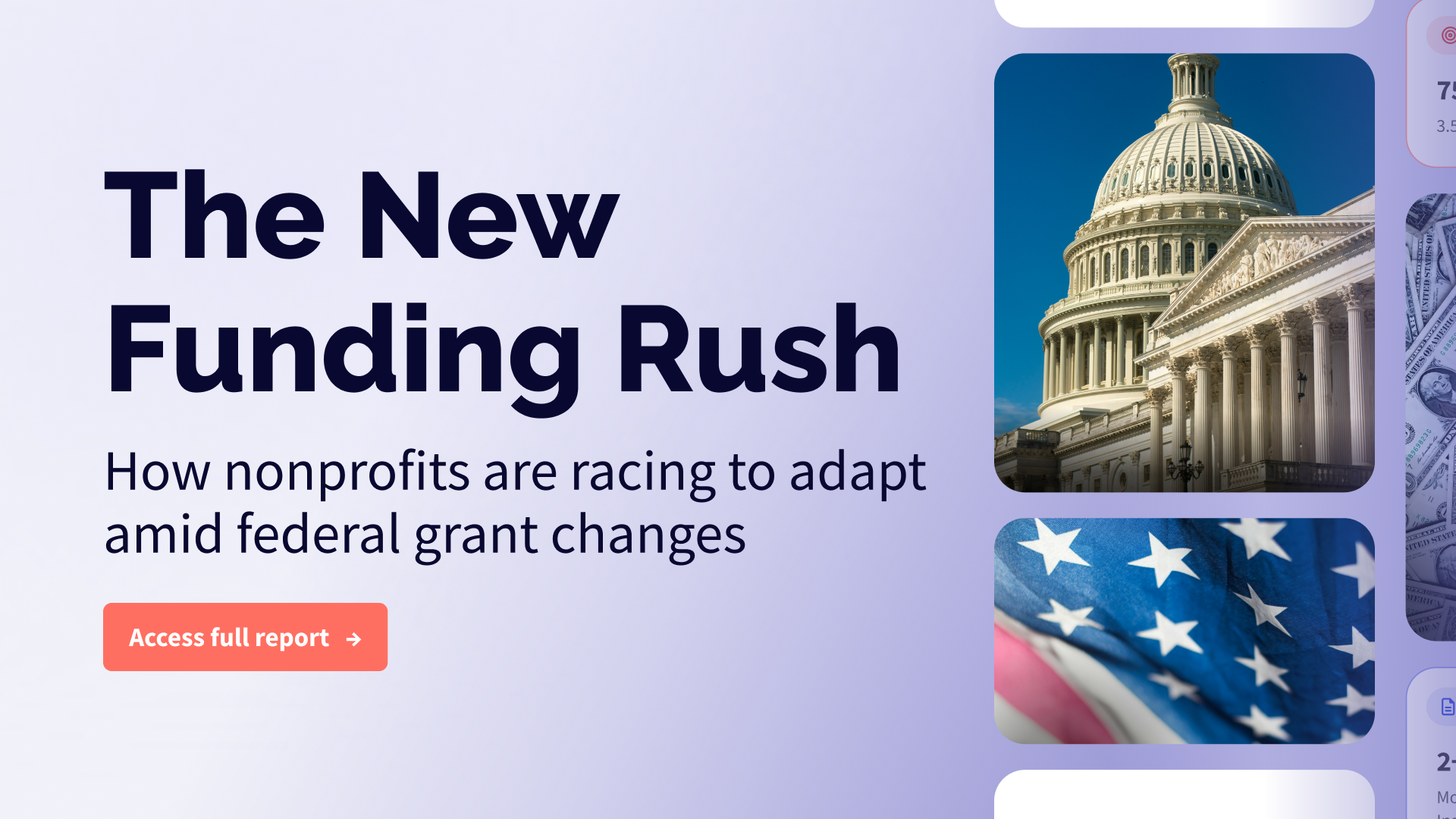
The New Funding Landscape
Federal funding has always shifted with political tides, but recent changes by the current administration are disrupting nonprofits at an unprecedented scale. Recent moves - including efforts to scale back AmeriCorps, suspend refugee resettlement support, and cut USDA food assistance programs - have shown that even long-standing funding streams can disappear overnight.
The result? A sector where uncertainty is the norm—even for organizations that haven’t yet lost dollars.
Inside the Numbers: What 300+ nonprofits told us about today’s climate
Our 2025 survey of over 300 nonprofits reveals near-universal uncertainty regarding federal grants.
Here’s what we found:
Misalignment with federal priorities is widespread. Six in ten nonprofits say their missions aren’t fully aligned with the government’s funding priorities.
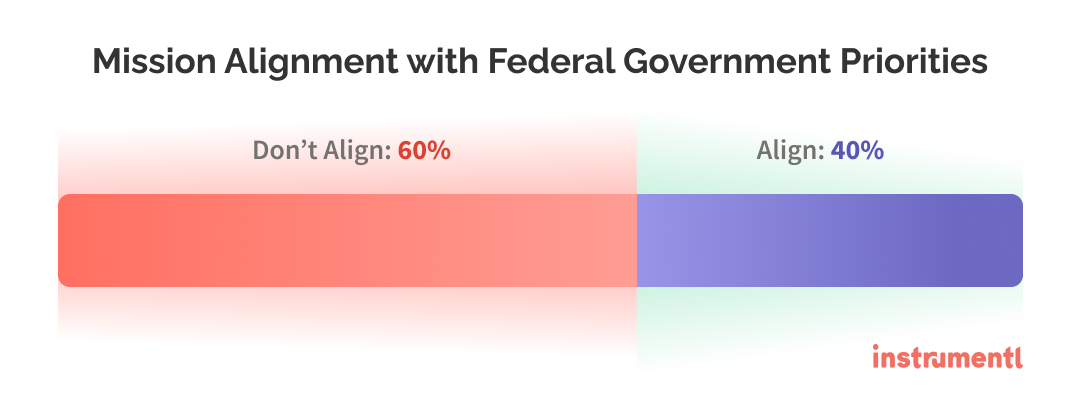
Likewise, ripple effects go beyond direct losses.
85% of all respondents said federal funding changes have impacted them. For half of the respondents, that impact is direct funding cuts. But for many others, the effects are showing up in different ways - from cancelled opportunities to delayed disbursements to reductions in staff capacity.
- Only 15% of respondents had no meaningful impact on their grant funding
- Positively, 16% of respondents found new or unexpected opportunities
- 53% have experienced delays in grant funding decisions or disbursement schedules
- 24% have had to reduce staff or contractor capacity
- 58% of respondents have had grants they planned to pursue be cancelled or made irrelevant
- 51% of nonprofits surveyed have lost federal, state, or local grant funding
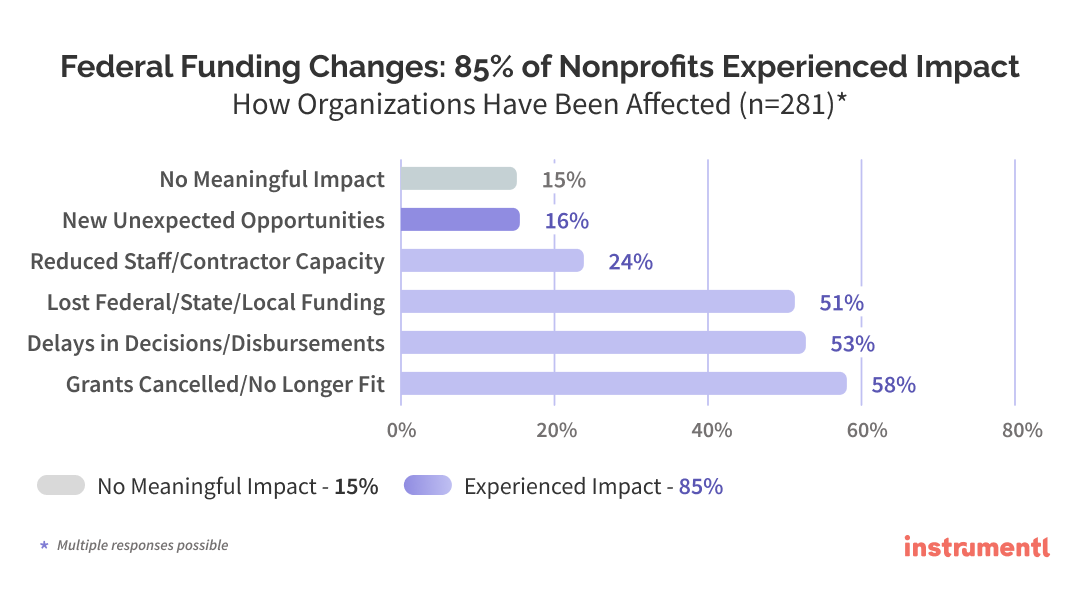
Even nonprofits that haven’t had a grant pulled are feeling the effects. The funding environment itself has become less stable and more unpredictable, creating challenges across the sector.
Jody Karr, Grants Manager & Strategic Resource Development at Conservation Corps, shared,
“Three of our five AmeriCorps grants were terminated, forcing us to suspend programming and reduce staff.”
But nonprofits aren’t simply pausing or retreating - many are adapting quickly. Celeste Harris, from Higher Expectations for Racine County, explained that while federal changes have disrupted FAFSA support, mentoring, and workforce readiness programs, it has also spurred stronger collaboration:
“We’ve diversified our funding strategy by pursuing more corporate and private foundation support, and by strengthening collaborations across the county to maximize collective resources.”
Erica Parrigin, Director of Grants Management at World Relief Quad Cities, explained:
“When refugee admissions ended in January, we lost over $2 million overnight. We had to furlough staff and expect future layoffs.”
Erica is not alone. Confidence levels remain shaky. If this climate of uncertainty has left you questioning your organization’s resilience, you’re not alone.
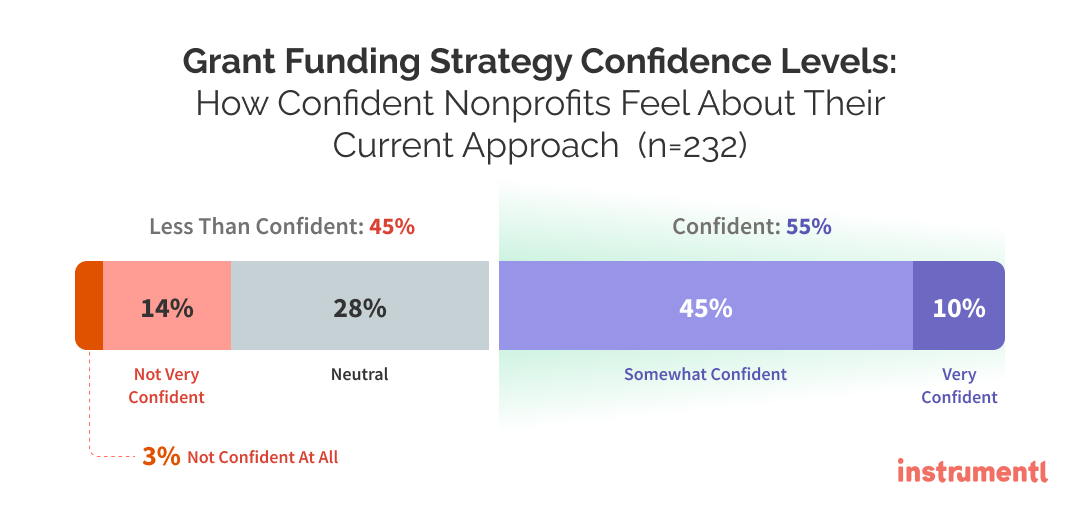
- Just over half (55%) of nonprofits say they feel confident in their strategies
- Only 10% report being very confident.
- Nearly half (45%) fall into the “less confident” or neutral category.
- 28% feel neutral about their current grant strategies
- 14% are not very confident
- 3% are not confident at all in their current grant strategies
What does this mean for nonprofits?
The data and stories together reveal a sector under pressure: fragile strategies, program interruptions, and communities left vulnerable when federal priorities shift. Even organizations that feel “somewhat confident” may need to assess the resilience of their grant seeking approach to ensure they can withstand further disruption.
The takeaway is clear: Federal shifts are creating instability across the grant landscape. With 85% of nonprofits reporting some sort of impact - and nearly half uncertain about their current strategies - organizations are being pushed to adapt.
So, what are they doing?
For most, the answer is diversification.
Diversification Is The #1 Strategy For Nonprofits
In the face of federal instability, nonprofits are reshaping their funding strategies. Organizations are experimenting with many approaches - from tapping donor-advised funds, to launching new campaigns and events, to simply submitting more applications.
Our survey shows that the most significant shift is into private and corporate grants, with 82% of survey respondents reporting that they’re expanding these parts of their portfolios.
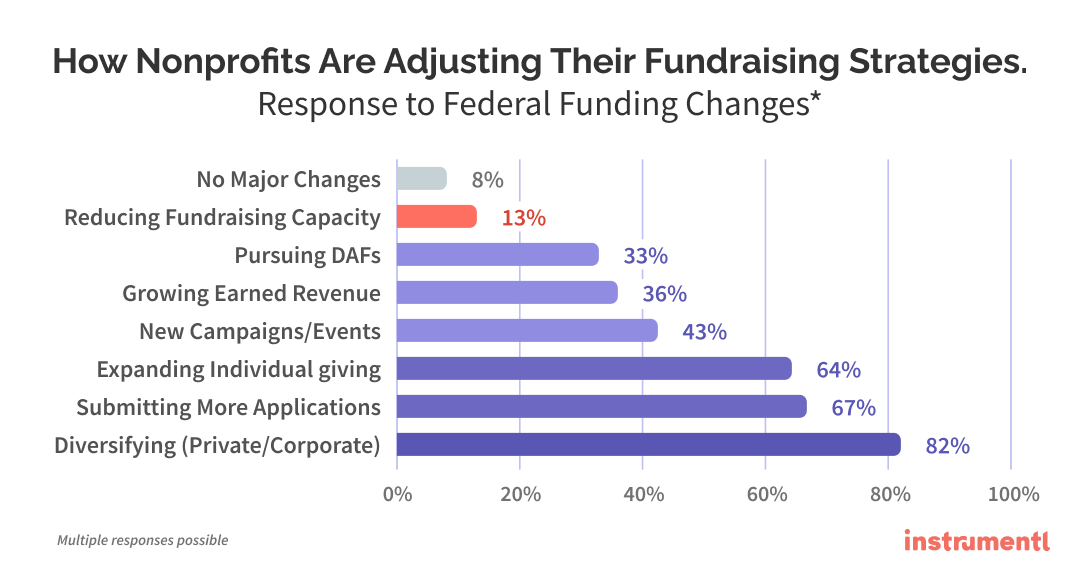
- Only 8% of nonprofits report making no major changes. Nearly everyone else is adjusting their strategy.
- A huge majority (82%) are diversifying into private and corporate funding.
- 67% are submitting more applications.
- 64% are expanding efforts to grow donor bases.
- 43% are launching new campaigns/events, and 36% are growing earned revenue.
- Only 33% are pursuing Donor-Advised Funds (DAFs).
- 13% have reduced fundraising capacity.
Diversification to private grants is the single most common adjustment to federal funding changes. The trend is even more pronounced among organizations that have already lost federal funding.
Liz Stillman, Business and Grants Manager at Starting Point: Services for Victims of Domestic and Sexual Violence, told us,
“We’ve filled some of the gap [of lost federal dollars] with private funds, but we’re already stretched thin. We wanted to bring on new advocacy staff, but the cuts made that impossible.”
Among organizations that reported losing federal funding, the top adjustment is a pivot to private and corporate grants. One in three (33%) chose this path amongst other changes.
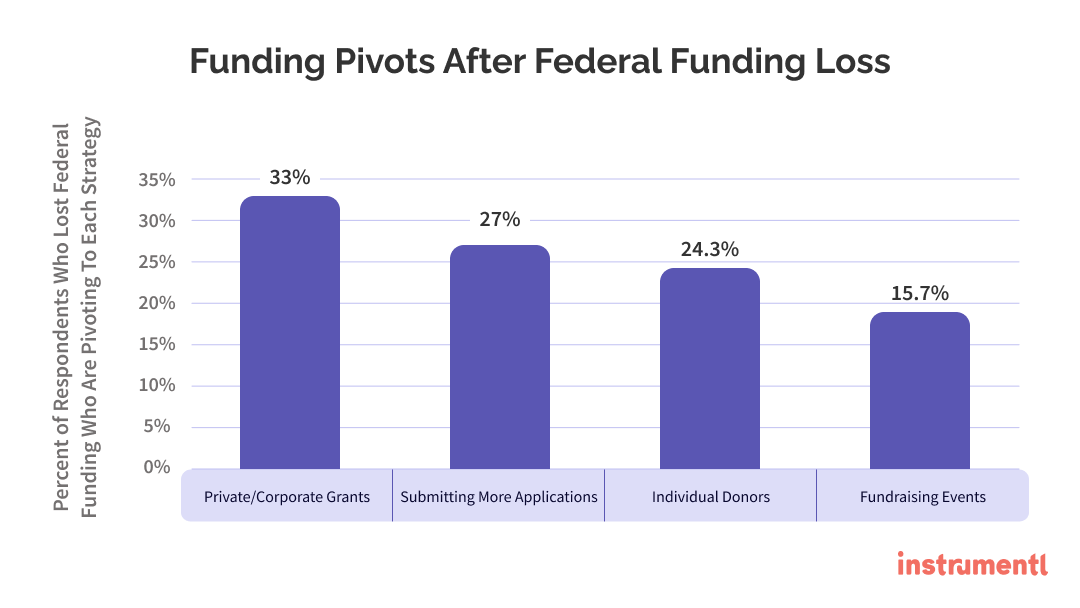
Put simply, private funders are being asked to fill large gaps left by shifts in federal funding priorities..
Macarena Dagnino Johnson, Development Manager at Action Council of Monterey County, shared:
“The number of grantees applying for grants from private organizations has been increasing exponentially, which has made us less visible to our regular sponsors and put us at a disadvantage.”
Inevitably, there will be much more competition for the same pools of corporate and foundation dollars. As a result, there will be higher stakes placed on differentiation, compliance, and relationship-building to stand out.
A faith-based nonprofit fighting homelessness in Washington State shared how they are standing out amid higher competition:
“We do see a higher competitiveness because there are fewer federal grants. As such, we are increasing our engagement with foundations and corporations. We have connected with and built relationships with over 50% of our funders, thereby reducing the number of "cold" proposals. As a result, we've seen a 192% increase in revenue over the last 3 years. This year, we will submit over 92 proposals in our funding landscape.”
What does this mean for nonprofits?
Diversification is a necessary move, but it also introduces new demands.
With pipelines widening and standards rising, nonprofits will need to plan for the competitive reality of 2026 and beyond - where more players are vying for the same private dollars, and operational excellence becomes a differentiator.
Brute Force Applications: Volume Over Bandwidth
After diversification, the second most common response to federal funding changes is to increase the number of grant applications sent. Many teams see this as the fastest lever they can pull to try to replace lost revenue.
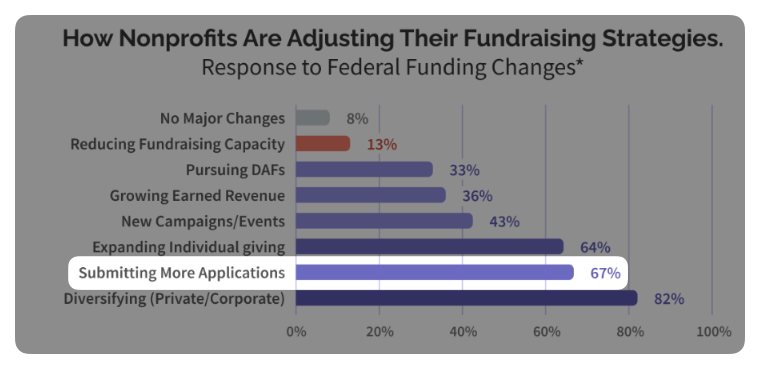
Over two-thirds (67%) of organizations in our survey reported submitting more applications than before, making this the second most common adoption strategy.
Zooming in on just those who responded that they lost federal funding, 27% are going to submit more applications than they originally planned.
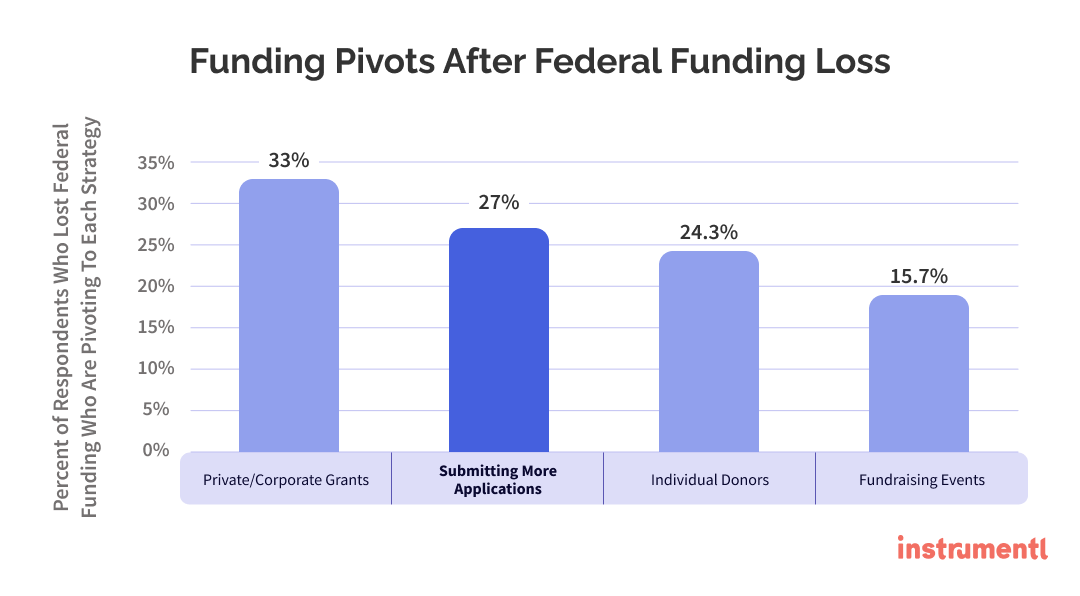
It’s easier said than done. Losing a single $2 million federal grant can mean pursuing 10-20 smaller private awards to fill the gap. A team that once managed one large grant now needs an entirely new process to find, research, write, win, and manage dozens of smaller grants - including workflows, reviews, compliance, and stewardship. Not every organization has that bandwidth on hand.
Mary Yancey, Grants Administrator at Camp McDowell, a noted:
“We are writing more grant requests to private foundations, but we are getting more denials. I have been told that they are being inundated with requests from people trying to make up for the loss of federal funding.”
This sense of urgency is understandable, but it risks overwhelming staff and stretching teams too thin. In a separate report we released this year, we found that 42% of nonprofit employees report feeling burned out, emotionally exhausted, or overwhelmed in the past year. This urgency can compound existing pressure.
Gay Burden, Director of Developmental Operations at Second Harvest Food Bank of Middle Tennessee, described how, after losing nearly a third of USDA-supplied food, she turned to Instrumentl to rapidly start filling that gap.
“Instrumentl helped us close our federal funding gap really fast. I found ten new grants in a single weekend—and we had our first win within six weeks.”
In one weekend, her team identified ten strong, values-aligned leads - and quickly secured their first new private grant to start closing the gap. For them, urgency drove action, but strategy converted it into results.
What does this mean?
Applying to multiple grants may be necessary, but a scattershot approach alone is neither sustainable nor strategic. Nonprofits that pair increased output with more strategic targeting—using the right tools, standardizing workflows, and focusing on funder fit—will be better positioned to replace lost dollars without burning out their teams.
These shifts in volume and diversification point to a sector that is not just adapting to change, but bracing for the long game. The real question is: what does this mean as nonprofits look toward 2026 and beyond?
Further Diversification Outside of Grants
Expanding into private and corporate grants is the sector’s primary pivot, and increasing application volume comes in close behind. But nonprofits aren’t stopping there.
Many are testing additional funding strategies that add important layers of resilience:
- 33% are tapping donor-advised funds (DAFs).
- 36% are building earned revenue streams.
- 43% are launching new campaigns or events.

These shifts may not be as widespread as the push toward private grants or the increase in application numbers, but they reflect a willingness to innovate beyond the grant space.
One leader at a national arts organization based in Indianapolis told us,
“We have had to shift our programming so that we can raise money incrementally throughout the year to cover expenses, rather than doing one large festival, which brought a lot of national attention to our work.”
In addition, a grant professional at a Children’s Museum in California explained,
“Recent policy shifts, including the new Executive Order, have highlighted the need for a more proactive and adaptive approach. To stay informed, our team is attending webinars and trainings that focus on federal policy updates, and their implications for grant management - including an Instrumentl webinar in August, which was super helpful.”
For example, DAF engagement at 33% shows that funding vehicles once limited to large institutions are now being embraced by organizations of all sizes.
A grant manager at a notional disabilities services nonprofit shared how they are investing more into their major gifts and earned revenue:
“We are focusing on growing relationships with high-capacity individuals and foundations (i.e., those who have the ability to give $100,000 or more). Our organization already has a diverse range of funding streams, including revenue-generating social enterprises, and we're looking to strengthen all those areas.”
Equally notable: very few organizations are standing still. Only 8% reported maintaining the status quo.
Federal changes are prompting nearly universal action. And despite budget pressures, just 13% said they’re reducing fundraising capacity - a clear signal that most leaders see growth and experimentation as the only viable path forward.
One respondent told us:
“The elimination of DEI initiatives … has devastated organizations serving women and BIPOC. We have shifted our focus to foundations and businesses that are mission- and issue-aligned.”
Another added:
“Relationships with foundation trustees are becoming essential - a great thing for nonprofits that can cultivate them, but a challenge for smaller orgs.”
Importantly, these shifts aren’t limited to nonprofits that lost federal funding. Even organizations that never relied on federal dollars are being affected, because they now find themselves competing against former federal grantees entering the private and corporate space. In today’s landscape, every nonprofit has to adapt.
And most organizations are not choosing just one approach. Crucially, these strategies often co-occur with grant diversification and volume increases. They don’t replace the primary pivots; instead, they round out a layered approach to closing gaps and preparing for uncertainty.
What does this mean for nonprofits?
These additional strategies matter. They show a sector leaning into creativity and refusing to shrink back. For nonprofit leaders, the lesson is clear: building resilience means pulling multiple levers, in addition to securing grants.
Looking Ahead: 2026 and Beyond
The shifts nonprofits are making today—diversifying into private grants, increasing application volume, and exploring additional funding strategies—will only intensify.
Leaders are already anticipating what that future will demand.
Others, like Miki Howald, Director of Grants and Foundation Relations at Pittsburgh Foodbank, are grappling with the scale of federal losses:
“We lost food donations and cash funds from the USDA when the CCC (Commodity Credit Corporation) was eliminated. The estimated value of this loss is 6 million pounds of food valued at $5 million.”
But alongside the challenges, nonprofits are also finding new ways forward. Some are piloting new program models that reduce dependency on federal dollars.
Jody Karr, at Conservation Corps, shared that her team is “piloting new program models in 2025 that will not be dependent on federal funding for success.”
Others are strengthening collaboration with local partners to stretch resources further and sustain programming. And many are investing in building stronger donor and foundation relationships, ensuring they have multiple levers to pull when federal funding shifts.
As one leader put it:
“Relationships with foundation board or trustees are necessary for a foot in the door these days - a great thing for nonprofits that have the capacity to build them.”
Federal funding instability is likely to persist, and the private funding space will continue to grow increasingly crowded.
Nonprofits that rely on scattershot approaches risk falling behind, while those that invest in smarter prospecting, stronger compliance, and more efficient grant writing will be better equipped to compete.
Instrumentl built a platform to address the exact challenges this report highlights.
- Finding the right fit faster. As competition intensifies, good-fit opportunities are more important than ever. Instrumentl’s AI grant matching technology and funder insights help grant writers generate drafts and tailor proposals quickly - without sacrificing quality.
- Writing more proposals, more efficiently. Rising application volume means bandwidth is stretched. Our AI-powered grant writing tools help you generate drafts and tailor proposals without sacrificing quality.
- Managing complex relationships with ease. More smaller funders means more reporting, compliance, and budgets to track. Instrumentl centralizes all of this in one place, making it easier to stay on top of deadlines and funder requirements.
Join over 4,500 nonprofits already using Instrumentl to diversify their grants. Start your 14-day free trial today.
Methodology
This report is based on a survey of 300+ nonprofit professionals from organizations that are currently managing grants. Respondents represented a mix of organization sizes, missions, and geographic locations, but all shared the common thread of having a grant program in place.
What We Asked.
The survey included questions on how nonprofits are being affected by federal funding changes, what strategies they’re using in response, how confident they feel about their current approaches, and what their grant application pipelines and success rates look like. We also asked open-ended questions so respondents could share stories about how these shifts are playing out in their day-to-day work.
Disclaimer
This was a non-probability survey, designed to provide a snapshot of 300+ nonprofit leaders who chose to participate. The results should be understood as directional benchmarks, as they reveal patterns, common challenges, and strategies that many nonprofits are employing. However, they shouldn’t be interpreted as generalizations for the entire sector. Think of this report as a way to compare your own experience with what peers are seeing and to spot broader trends shaping the grant-seeking landscape.

.svg)



